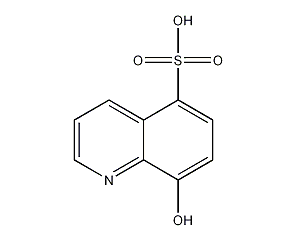
Structural formula
| Business number | 01V8 |
|---|---|
| Molecular formula | C9H7NO4S |
| Molecular weight | 225.22 |
| label |
8-Hydroxy-5-quinolinesulfonic acid, 5-Sulfonic acid-8-hydroxyquinoline, 5-Sulfo-8-hydroxyquinoline |
Numbering system
CAS number:84-88-8
MDL number:MFCD00006795
EINECS number:201-570-5
RTECS number:VC2570000
BRN number:None
PubChem number:24895427
Physical property data
1. Character:Light yellow needle-like crystals or crystalline powder
2. Density (g/mL ,25/4℃): Undetermined
3. Relative vapor density (g /mL,Air= 1): Undetermined
4. Melting point (ºC):213℃(decomposed)
5. Boiling point (ºC,Normal pressure): Undetermined
6. Boiling point (ºC,5.2 kPa): Undetermined
7. Refractive Index: Undetermined
8. Flash point (ºC): Undetermined
9. Specific optical rotation (º ): Undetermined
10. Autoignition point or ignition temperature (ºC): Undetermined
11. Vapor pressure (kPa, 25ºC): Undetermined
Salmonella: 50 ug/L
Ecological data
None yet
Molecular structure data
1. Molar refractive index:53.98 2. Molar volume (m3/mol):137.9 3. isotonic specific volume (90.2K):415.9 4. Surface Tension (dyne/cm):82.5 5. Polarizability(10-24cm3):21.40
Compute chemical data
1. Reference value for hydrophobic parameter calculation (XlogP): None
2. Number of hydrogen bond donors: 2
3. Number of hydrogen bond acceptors: 5
4. Number of rotatable chemical bonds: 1
5. Number of tautomers: 2
6. Topological molecule polar surface area 95.9
7. Number of heavy atoms: 15
8. Surface charge: 0
9. Complexity: 324
10. Number of isotope atoms: 0
11. Determine the number of atomic stereocenters: 0
12. Uncertain number of atomic stereocenters: 0
13. Determine the number of chemical bond stereocenters: 0
14. Number of uncertain chemical bond stereocenters: 0
15. Number of covalent bond units: 1
Properties and stability
None yet
Storage method
This product should be sealed in Store in a cool and dry place.
Synthesis method
By8-Original sulfonation of hydroxyquinoline. Cool the oleum with stirring to 10℃The following, gradually added8-Hydroxyquinoline, keep the temperature at15℃below. After adding, raise the temperature to 30℃The following stirring reaction5h. Leave overnight. The next day, put the reaction solution into 8-10double the amount of water (press8-Hydroxyquinoline meter), control temperature60℃, precipitate the crystals, and then leave it overnight. Filter, wash and dry.
Purpose
Used as organic synthesis intermediates and analytical reagents.
s: list 18.0pt; mso-pagination: widow-orphan” align=left>
Compute chemical data
1. Reference value for hydrophobic parameter calculation (XlogP): None
2. Number of hydrogen bond donors: 2
3. Number of hydrogen bond acceptors: 5
4. Number of rotatable chemical bonds: 1
5. Number of tautomers: 2
6. Topological molecule polar surface area 95.9
7. Number of heavy atoms: 15
8. Surface charge: 0
9. Complexity: 324
10. Number of isotope atoms: 0
11. Determine the number of atomic stereocenters: 0
12. Uncertain number of atomic stereocenters: 0
13. Determine the number of chemical bond stereocenters: 0
14. Number of uncertain chemical bond stereocenters: 0
15. Number of covalent bond units: 1
Properties and stability
None yet
Storage method
This product should be sealed in Store in a cool and dry place.
Synthesis method
By8-Original sulfonation of hydroxyquinoline. Cool the oleum with stirring to 10℃The following, gradually added8-Hydroxyquinoline, keep the temperature at15℃below. After adding, raise the temperature to 30℃The following stirring reaction5h. Leave overnight. The next day, put the reaction solution into 8-10double the amount of water (press8-Hydroxyquinoline meter), control temperature60℃, precipitate the crystals, and then leave it overnight. Filter, wash and dry.
Purpose
Used as organic synthesis intermediates and analytical reagents.
mily: 宋体”>
Purpose
Used as organic synthesis intermediates and analytical reagents.

 微信扫一扫打赏
微信扫一扫打赏

